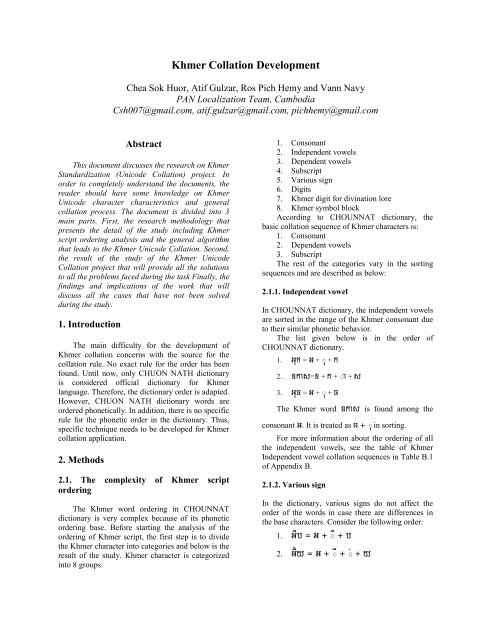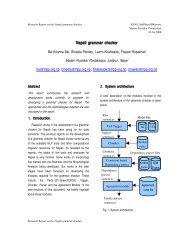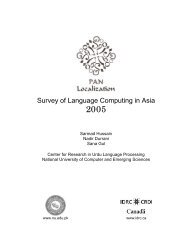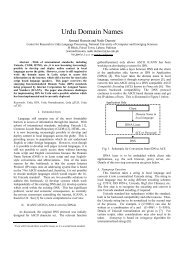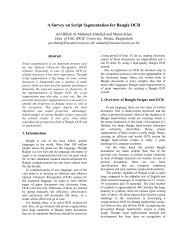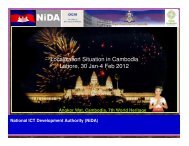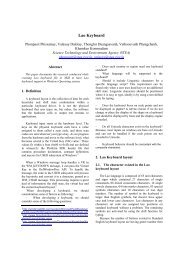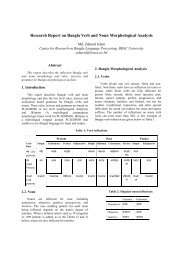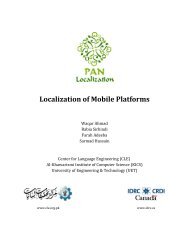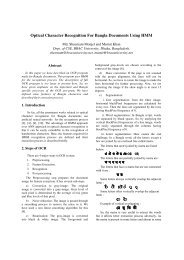Khmer Collation Development - PAN Localization
Khmer Collation Development - PAN Localization
Khmer Collation Development - PAN Localization
You also want an ePaper? Increase the reach of your titles
YUMPU automatically turns print PDFs into web optimized ePapers that Google loves.
<strong>Khmer</strong> <strong>Collation</strong> <strong>Development</strong><br />
Chea Sok Huor, Atif Gulzar, Ros Pich Hemy and Vann Navy<br />
<strong>PAN</strong> <strong>Localization</strong> Team, Cambodia<br />
Csh007@gmail.com, atif.gulzar@gmail.com, pichhemy@gmail.com<br />
Abstract<br />
This document discusses the research on <strong>Khmer</strong><br />
Standardization (Unicode <strong>Collation</strong>) project. In<br />
order to completely understand the documents, the<br />
reader should have some knowledge on <strong>Khmer</strong><br />
Unicode character characteristics and general<br />
collation process. The document is divided into 3<br />
main parts. First, the research methodology that<br />
presents the detail of the study including <strong>Khmer</strong><br />
script ordering analysis and the general algorithm<br />
that leads to the <strong>Khmer</strong> Unicode <strong>Collation</strong>. Second,<br />
the result of the study of the <strong>Khmer</strong> Unicode<br />
<strong>Collation</strong> project that will provide all the solutions<br />
to all the problems faced during the task Finally, the<br />
findings and implications of the work that will<br />
discuss all the cases that have not been solved<br />
during the study.<br />
1. Introduction<br />
The main difficulty for the development of<br />
<strong>Khmer</strong> collation concerns with the source for the<br />
collation rule. No exact rule for the order has been<br />
found. Until now, only CHUON NATH dictionary<br />
is considered official dictionary for <strong>Khmer</strong><br />
language. Therefore, the dictionary order is adapted.<br />
However, CHUON NATH dictionary words are<br />
ordered phonetically. In addition, there is no specific<br />
rule for the phonetic order in the dictionary. Thus,<br />
specific technique needs to be developed for <strong>Khmer</strong><br />
collation application.<br />
2. Methods<br />
2.1. The complexity of <strong>Khmer</strong> script<br />
ordering<br />
The <strong>Khmer</strong> word ordering in CHOUNNAT<br />
dictionary is very complex because of its phonetic<br />
ordering base. Before starting the analysis of the<br />
ordering of <strong>Khmer</strong> script, the first step is to divide<br />
the <strong>Khmer</strong> character into categories and below is the<br />
result of the study. <strong>Khmer</strong> character is categorized<br />
into 8 groups:<br />
1. Consonant<br />
2. Independent vowels<br />
3. Dependent vowels<br />
4. Subscript<br />
5. Various sign<br />
6. Digits<br />
7. <strong>Khmer</strong> digit for divination lore<br />
8. <strong>Khmer</strong> symbol block<br />
According to CHOUNNAT dictionary, the<br />
basic collation sequence of <strong>Khmer</strong> characters is:<br />
1. Consonant<br />
2. Dependent vowels<br />
3. Subscript<br />
The rest of the categories vary in the sorting<br />
sequences and are described as below:<br />
2.1.1. Independent vowel<br />
In CHOUNNAT dictionary, the independent vowels<br />
are sorted in the range of the <strong>Khmer</strong> consonant due<br />
to their similar phonetic behavior.<br />
The list given below is in the order of<br />
CHOUNNAT dictionary.<br />
1. ΒН˝ = Β + ˘Н + ˝<br />
2. Χ˝Ј₤=Χ + ˝ + ˘Љ + ₤<br />
3. ΙНş = Β + ˘Н + ş<br />
The <strong>Khmer</strong> word Χ˝Ј₤ is found among the<br />
consonant Β. It is treated as Β + ˘Н in sorting.<br />
For more information about the ordering of all<br />
the independent vowels, see the table of <strong>Khmer</strong><br />
Independent vowel collation sequences in Table B.1<br />
of Appendix B.<br />
2.1.2. Various sign<br />
In the dictionary, various signs do not affect the<br />
order of the words in case there are differences in<br />
the base characters. Consider the following order:<br />
1. ΒЙĀ = Β + ˘Й + Ā<br />
2. ΙЙяŎ = Β + ˘Й + ˘э + Ŏ
<strong>Khmer</strong><br />
3. ΒЙũмНĀ = Β + ˘Й + ũ + ˘л + ˘Н + Ā<br />
The various ˘э (VISAGNI) is not counted for<br />
the comparison process.<br />
(Note: For the order among the various signs, it is<br />
considered sorted according to its sound. See the<br />
Table B.2 of the Appendix B.)<br />
2.1.3. Digits, <strong>Khmer</strong> digit for divination lore and<br />
<strong>Khmer</strong> Symbol block<br />
Because the order of <strong>Khmer</strong> digit, digit for<br />
divination lore and <strong>Khmer</strong> symbol block are not<br />
mentioned in the CHUON NATH dictionary and<br />
there is no other resource found for its ordering, it is<br />
decided to sort them after all the rest of base<br />
character categories. The order among the three<br />
categories is:<br />
1. <strong>Khmer</strong> digit<br />
2. <strong>Khmer</strong> numeric symbol for divination lore<br />
3. <strong>Khmer</strong> lunar date symbol<br />
2.1.4. <strong>Khmer</strong> vowels ˘й (REAHMUK)<br />
The sorting order of REAHMUK varies in the<br />
CHUON NATH dictionary.<br />
- If there is another dependent vowel before the<br />
various sign REAHMUK, the REAHMUK is<br />
treated as the <strong>Khmer</strong> consonant ΅ (HA) due to<br />
its phonetic similarity.<br />
- If the REAHMUK is isolated from other<br />
dependent vowel, it is sorted after the vowel Је<br />
(<strong>Khmer</strong> vowel SRAK AM)<br />
2.1.5. BA (Ā) word lists<br />
As mentioned in the previous section, the various<br />
signs are treated as ignorable during the sorting<br />
process, but it is an exceptional case for the various<br />
sign ˘л and ˘п (MUUSIKATOAN and TRIISAP) in<br />
the Ā (BA) word list. It is because of the sound. The<br />
order is as follows:<br />
- Ā (BA)<br />
- Āл = Ā + ˘л<br />
For example, ă is always smaller than Āл.<br />
2.2. High Level System Architecture<br />
As illustrated in Figure A.1 of Appendix A, the<br />
proposed system is developed by dividing its<br />
functionalities into 4 main modules, which will be<br />
described later in this section. This division will<br />
make the system more reusable and efficient,<br />
because each module can be implemented with the<br />
technologies best suited to it and the modification of<br />
one module does not affect the other, which is easy<br />
to control.<br />
2.2.1. External Application<br />
This module focuses on all the user applications that<br />
need the functionality of the <strong>Collation</strong> Engine to<br />
compare their <strong>Khmer</strong> Unicode strings. For example,<br />
the sorting engine. The modification of the collation<br />
engine does not affect this module.<br />
2.2.2. <strong>Collation</strong> and Normalization Engine<br />
This part of the system plays a very important role.<br />
It is designed to be the common library or assembly<br />
that all the external applications will use for their<br />
comparison tasks so that they can have a unified<br />
collation algorithm for their application. There are<br />
two mains modules for this part of the system. First,<br />
the Normalization engine is an engine such that its<br />
functionality is to normalize the <strong>Khmer</strong> Unicode<br />
word into a common word with respect to <strong>Khmer</strong><br />
spelling order. Second, the <strong>Collation</strong> engine is an<br />
engine that is responsible for collating the <strong>Khmer</strong><br />
strings.<br />
2.2.3. Data Reader Engine<br />
This module is an interface between the collation<br />
and normalization engine and the data. It prevents<br />
those engines from accessing the data directly,<br />
which makes thing more complex and unreliable.<br />
2.2.4. Data<br />
This module focuses on all fundamental data that is<br />
needed during the process of the collation<br />
application. For example, as the collation is based<br />
on CHOUN NAT dictionary, its word list must be<br />
included in this part.<br />
- Āп = Ā + ˘п<br />
224
Working Papers 2004-2007<br />
2.3. General <strong>Khmer</strong> <strong>Collation</strong> Algorithm<br />
2.3.1. The requirements and constraints of the<br />
collation Engine<br />
The task of the <strong>Collation</strong> Engine is to give the<br />
possibility to compare two <strong>Khmer</strong> Unicode scripts<br />
for the correct order. The requirements of the engine<br />
are:<br />
- The collation must give the result of the<br />
comparison according to CHUON NATH<br />
dictionary.<br />
- For the words that do not exist in CHUON<br />
NATH dictionary, the most common rule that is<br />
extracted from the dictionary must be applied.<br />
2.3.2. Problem analysis<br />
There are two main problems:<br />
Problem A:<br />
In any circumstance, CHUON NATH dictionary<br />
order must be adapted as it is the only official<br />
dictionary for <strong>Khmer</strong> language. However, the words<br />
in the dictionary are ordered phonetically. For<br />
example:<br />
1. Ā˝ijЊ = Ā + ˝ + ij + ˘Њ<br />
2. Ā₣с = Ā + ₣ + ˘с<br />
Visibly, the order must be the first word before<br />
the second one as the base consonant ˝ (KA) is<br />
smaller than ₣ (NGO). Unfortunately, according to<br />
CHUON NATH dictionary the order is in contrary.<br />
The reason is the pronunciation of the two words.<br />
Solution A:<br />
Since there is no rule for the problem above, the<br />
solution is to store all the words of CHUON NATH<br />
dictionary so that all the words that exists in the<br />
dictionary will be kept as their original order.<br />
Problem 2:<br />
<strong>Khmer</strong> Unicode font makes it possible for the user<br />
to represent a word or syllable in different way.<br />
For example, the word ū₤ʼn Б can be typed in two<br />
different ways:<br />
ū₤ʼn Б = ₤ + ˘ʼn + Ū˘ + ˘Б<br />
ū₤ʼn Б = ₤ + Ū˘ + ˘ʼn + ˘Б<br />
In user perspective, the two strings are considered<br />
the same according to its visibility. However, in the<br />
computer, the two strings are different because of<br />
the order.<br />
Solution B<br />
The solution is to do some processing before the<br />
comparison. The process is called normalization.<br />
The normalized string must respect the spelling<br />
order of <strong>Khmer</strong> language.<br />
2.3.3. General process of <strong>Khmer</strong> <strong>Collation</strong><br />
After the analysis of the problems, the main<br />
algorithm for the <strong>Khmer</strong> Unicode <strong>Collation</strong> is:<br />
1. Get the two strings to be collated<br />
2. Normalize the two strings into a common<br />
form of <strong>Khmer</strong> word that respect the<br />
<strong>Khmer</strong> spelling order<br />
3. Search for index of the two words in the<br />
CHUON NATH dictionary<br />
4. If one of the two normalized words is not<br />
found in CHOUNNAT dictionary word<br />
lists, apply a rule that is extracted from the<br />
dictionary.<br />
Therefore, there are three main processes for<br />
<strong>Khmer</strong> Unicode collation: <strong>Khmer</strong> Normalization,<br />
Get the index of the word from the CHOUNNAT<br />
dictionary, and the general term of collation process.<br />
2.3.4. <strong>Khmer</strong> Unicode Normalization<br />
The main task of the <strong>Khmer</strong> Unicode Normalization<br />
is to standardize those string given into a unique<br />
sequence that respect to the <strong>Khmer</strong> spelling order.<br />
2.3.4.1. General Process of <strong>Khmer</strong><br />
Normalization<br />
The general processes of the Normalization engine<br />
are:<br />
- First, the non-normalized string is converted<br />
into a common array of <strong>Khmer</strong> script and<br />
remains the in order of non-normalized string.<br />
In this step, the Normalization engine can<br />
recognize the nature of the Unicode given<br />
whether it is a consonant or a subscript or a<br />
vowel etc…<br />
225
<strong>Khmer</strong><br />
- After getting the array of <strong>Khmer</strong> script, the<br />
Normalization engine will detect each<br />
orthographic syllable and arrange them into a<br />
normalized string with respect to <strong>Khmer</strong><br />
spelling order.<br />
2.3.4.2. <strong>Khmer</strong> Unicode spelling order<br />
The ordering of <strong>Khmer</strong> spelling is as given below:<br />
1. Base consonant<br />
2. First subscript<br />
3. Second subscript<br />
4. Consonant shifter<br />
5. Vowel<br />
6. Various signs<br />
The <strong>Khmer</strong> subscript can be divided into 3<br />
categories:<br />
- South subscript: the subscript that is placed<br />
below the base character<br />
- West subscript : the subscript that is<br />
rendered on the left side of the base<br />
character<br />
- East subscript: the subscript that is placed<br />
on the right side of the base character<br />
The priorities of the input sequences of the 3 types<br />
of subscript are as below:<br />
1. South subscript<br />
2. East subscript<br />
3. West subscript<br />
The independent vowel and digit are considered the<br />
stand-alone character, i.e. single orthographic<br />
syllable.<br />
2.3.4.3. Syllable detection<br />
The idea to detect syllable is to detect the transition<br />
state of each character of the input string. If there is<br />
no possible transition for a character, it means the<br />
end of orthographic syllable is reached.<br />
The detection of each syllable depends on the<br />
possibility of transition between characters.<br />
Therefore, it is required to analyze all the<br />
possibilities of the input sequence and create<br />
possible transition lookup table. For the complete<br />
lookup table for the development of <strong>Khmer</strong> Unicode<br />
Normalization and its description, see the Table B.3<br />
of Appendix B.<br />
2.3.5. <strong>Khmer</strong> <strong>Collation</strong> element table<br />
After the analysis of some <strong>Khmer</strong> words in the<br />
dictionary, two levels of comparison for <strong>Khmer</strong> are<br />
defined.<br />
1. The first level focuses on all the <strong>Khmer</strong><br />
base characters. It mainly consists of<br />
consonants, subscripts, dependent vowels,<br />
independent vowels, <strong>Khmer</strong> digit, <strong>Khmer</strong><br />
numeric symbol for divination lore, and<br />
<strong>Khmer</strong> symbol for lunar date.<br />
2. The second level focuses on all the <strong>Khmer</strong><br />
various signs.<br />
Multiple Mapping:<br />
For <strong>Khmer</strong> collation element table, it is not always<br />
simple as mapping from one character to one<br />
collation element. There is case of one to one<br />
mapping, one to many mapping (expansion), many<br />
to one mapping (contraction) and many to many<br />
mapping.<br />
Expansion: Example<br />
Χ(one single character) and ΒН(two characters)<br />
are considered to be the same in pronunciation.<br />
They are considered the same. However, if they<br />
happened to be compared with each other without<br />
others, the first one is bigger than the second one.<br />
Consider:<br />
The collation element of Β is [42.0]<br />
The collation element of ˘Н is [100.0]<br />
So collation element array of ΒН must be [42.0],<br />
[100.0]<br />
The collation element of Χ should be [42.0],<br />
[100.0], [0.1]<br />
Contraction: Example<br />
All <strong>Khmer</strong> subscript are represented by 2<br />
Unicode, 17D2 and the Unicode of the base<br />
character. However, it has to map into one collation<br />
element only.<br />
226
Working Papers 2004-2007<br />
Many to many mapping: Example<br />
˘Њй ˘Њ + ˘й<br />
3. Results<br />
˘Њ + ΅<br />
Since the word that exists in the CHUON NATH<br />
dictionary are indexed, the performance of <strong>Khmer</strong><br />
collation for the comparisons those words is 100%<br />
accuracy. The problem is to test the extracted rule<br />
by comparing the order using the rule and the order<br />
in the dictionary.<br />
To test for the performance of the rule, 100 pairs of<br />
words in the dictionary were randomly selected.<br />
Then, the rule is applied to each pair for its order<br />
with each other. After that, the order is compared<br />
with the order in the CHUON NATH dictionary.<br />
Within the 100 pairs, 94 pairs result the same as the<br />
order in the dictionary. It implies that if CHUON<br />
NATH dictionary is necessary for the order, the<br />
accuracy of <strong>Khmer</strong> collation reach 94%.<br />
4. Discussion<br />
4.1. <strong>Collation</strong> of <strong>Khmer</strong> date and time<br />
The <strong>Khmer</strong> collation engine does not provide<br />
an option for the collation of <strong>Khmer</strong> date and time.<br />
The reason is not the difficulty of the<br />
implementation, but the lack of resource for the<br />
format.<br />
4.2. Ordering of book titles<br />
There are some alerts for some specific<br />
ordering such as the title of the books or novel or<br />
etc. Actually, for that kind of ordering, elimination<br />
of some unnecessary words is required during the<br />
collation process in order to receive the expected<br />
ordering effectively. For example, in English, the<br />
words ‘a’ and ‘the’ are eliminated for some<br />
searching and sorting purposes in order to receive<br />
the most expected result.<br />
As the <strong>Khmer</strong> collation engine is the base<br />
operation for the <strong>Khmer</strong> standardization, the<br />
handling of this case might have a big effect on<br />
other usages. Therefore, there should be another<br />
collation application that can serve this specific<br />
purpose.<br />
4.3. The case of TA and DA in normalization<br />
The case of subscript of TA and DA is still a<br />
problem for the implementation of the <strong>Khmer</strong><br />
Unicode <strong>Collation</strong>. Actually, the visibility of the two<br />
subscripts is the same, but the code is different.<br />
Because of its similar visibility, the users usually<br />
have some confusion while typing one of the two<br />
characters. Therefore, when the users wish to sort<br />
their data, they might complain about it as the order<br />
must be according to the code of the character.<br />
We attempted to handle the case during the<br />
normalization phase by a study on the different<br />
usage between the two subscripts, but there is no<br />
exact rule for it. Therefore, it was decided to keep it<br />
as it is and leave it to the user to be very careful for<br />
what they exactly want to type.<br />
5. Conclusion<br />
Since the <strong>Khmer</strong> word ordering utility is mostly<br />
required for everyday use, the project is<br />
implemented using two platforms: Microsoft Visual<br />
Basic.NET and Java.<br />
The order given is satisfactory. If the user<br />
wishes to sort the CHOUNNAT dictionary, it is one<br />
hundred percent the same.<br />
Strength: As the project is developed by dividing<br />
the complexity in to small modules, each part can be<br />
developed using the algorithm best suited.<br />
Therefore, the main strength of the application is its<br />
reusability. This characteristic is advantageous in<br />
case the user expect a new sorting order for their<br />
collation. They just modify the collation element<br />
table file without the effect overall application.<br />
In addition, the isolating of <strong>Khmer</strong><br />
Normalization engine from <strong>Khmer</strong> <strong>Collation</strong> engine<br />
is very advantageous for further usage of the<br />
Normalization, as it is not only used for the<br />
<strong>Collation</strong> engine. It will be needed in the Searching<br />
utilities, spell checker and so on.<br />
Weakness: The only weakness of the collation<br />
application is the speed. If the user wishes to use the<br />
collation for sorting a huge amount of data such as<br />
database, it will take a long time. The reason is that<br />
there are many processes needed in the collation<br />
application, first the normalization, second the<br />
searching of each string in CHOUNNAT dictionary<br />
word list and then if the string is not found the most<br />
227
<strong>Khmer</strong><br />
common rule extracted from CHOUNNAT<br />
dictionary is applied.<br />
Future: For the future phase, the need to improve<br />
the speed of the collation engine is very necessary,<br />
as it is the base functionality for the <strong>Khmer</strong><br />
standardization. In fact, there is no problem for the<br />
sorting of a small amount of data, but if user wishes<br />
to sort a huge amount of data such as database, the<br />
speed must be more considerable.<br />
In addition, the option to collate <strong>Khmer</strong> time<br />
and date are not yet implemented, because <strong>Khmer</strong><br />
does not have exact time and date format.<br />
Since the collation engine is implemented as the<br />
common assembly or library, the user can use it for<br />
their further software development such as sorting<br />
of excel sheet or database.<br />
6. References<br />
[1] CHOUNNATH, Dictionnaire Cambodgien, Edition de<br />
L’Institut Bouddhique, Phnom Penh, 1967<br />
[2] http://www.unicode.org/charts/PDF/U1780.pdf<br />
[3] http://www.unicode.org/reports/<br />
Appendix A<br />
.<br />
External Application <strong>Collation</strong> and Normalization Data Reader API Data<br />
Lexicon<br />
Sorting Engine<br />
Normalization<br />
Normalization<br />
DataReader API<br />
Normalization<br />
Data<br />
Application 1<br />
Application 2<br />
<strong>Collation</strong> Engine<br />
<strong>Collation</strong><br />
DataReader API<br />
Dictionary Word<br />
List<br />
Application n<br />
<strong>Collation</strong><br />
Sequences for nodictionary<br />
words<br />
Figure A.1: High Level System Architecture of <strong>Khmer</strong> <strong>Collation</strong><br />
Appendix B<br />
Table B.1: <strong>Khmer</strong> independent vowel collation sequences<br />
No Unicode Character Substitution Predecessor<br />
1<br />
2<br />
17A3<br />
Ι Ι<br />
17A4<br />
Μ Β +˘Љ<br />
228
Working Papers 2004-2007<br />
3<br />
4<br />
5<br />
6<br />
7<br />
8<br />
9<br />
10<br />
11<br />
12<br />
13<br />
14<br />
15<br />
16<br />
17<br />
17A5<br />
Ο Β + ˘Њ<br />
17A6<br />
Σ Β +˘Б<br />
17A7<br />
Χ Β +˘Н<br />
17A8 Ϊ Χ<br />
17A9<br />
ΰ Β +˘Нй<br />
17AA<br />
έ Β +˘Р<br />
17AB<br />
ζ<br />
17AC<br />
ι<br />
ũ<br />
ζ<br />
17AD<br />
µ Ų<br />
17AE<br />
ο µ<br />
17AF<br />
υ Β +Я˘<br />
17B0<br />
ω Β +а˘<br />
17B1<br />
ό Β +Ю˘в<br />
17B2<br />
Ё ό<br />
17B3<br />
Є Β +Ю˘д<br />
Table B.2: <strong>Khmer</strong> Various Sign <strong>Collation</strong> Order<br />
No Unicode Character<br />
1<br />
17CE ˘э<br />
2<br />
17D3 ˘π<br />
3<br />
17D9 <br />
4<br />
17DA <br />
5<br />
17CA ˘п<br />
6<br />
17DC ˘ч<br />
229
<strong>Khmer</strong><br />
7<br />
8<br />
9<br />
10<br />
11<br />
12<br />
13<br />
14<br />
15<br />
16<br />
17<br />
18<br />
19<br />
20<br />
21<br />
22<br />
17D8 <br />
17C9 ˘л<br />
17C8 ˘к<br />
17CC ˘х<br />
17D4 ¤<br />
17D5 <br />
17CB ˘с<br />
17D7 <br />
17CF ˘є<br />
17D1 ˘ґ<br />
17D0 ˘њ<br />
17D6 <br />
17D2 ˘№<br />
17D8 <br />
17DC <br />
17DD<br />
Table B.3 : Transition table for detecting <strong>Khmer</strong> syllable<br />
C CS WV NV SV EV WSS ESS SSS VS<br />
C 0 1 1 1 1 1 1 1 1 1<br />
CS 0 0 1 1 1 1 1 1 1 1<br />
WS 0 0 0 0 0 0 1 1 1 1<br />
NV 0 0 0 0 0 0 1 1 1 1<br />
SV 0 0 0 0 0 0 1 0 0 1<br />
EV 0 0 0 0 0 0 1 0 0 1<br />
WSS 0 1 1 1 1 1 0 1 1 1<br />
ESS 0 1 1 1 1 1 1 0 1 1<br />
SSS 0 1 1 1 1 1 1 0 0 1<br />
VS 0 0 0 0 0 1 1 0 1 1<br />
230
Working Papers 2004-2007<br />
Table B.4 : Abbreviations<br />
Shortcut<br />
C<br />
CS<br />
WV<br />
NV<br />
SV<br />
EV<br />
WSS<br />
SSS<br />
ESS<br />
VS<br />
Abbreviation<br />
Consonant<br />
Consonant Shifter<br />
West Vowel<br />
North Vowel<br />
South Vowel<br />
East Vowel<br />
West Subscript<br />
South Subscript<br />
East Subscript<br />
Various Sign<br />
Initial states are: C<br />
Note: In the transition table:<br />
− 0 means NOT Possible transition and 1 means possible transition.<br />
− The current state is in ROW.<br />
− The transition state is in COLUMN.<br />
231


